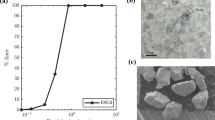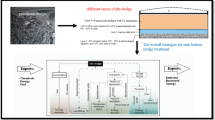For efficient separation of liquid heterogeneous systems in oil and gas industry, various types of sedimentation tanks, separators, hydrocyclones, etc. are used, the principle of which is based on gravitational and centrifugal separation of heterogeneous masses of different densities. In order to ensure the best hydrodynamic conditions for the process of suspensions separation in a hydrocyclone and to prevent clogging of the discharge hole, an apparatus that contains only the cylindrical part of the housing is proposed. The presence of a taper displacer ensures the maintenance of optimal hydrodynamic conditions along the entire length of the apparatus, from the inlet to the discharge hole. The taper of the displacer affects the distribution profile of the tangential velocities of the fluid in the near-wall region, ensuring the constancy of the velocity profile along the radius and the specific flow rate over the cross section of the apparatus. Basing on the results of studies carried out on a real product (a mixture of PVCR with water) at a pressure and flow rate corresponding to the production ones, an industrial prototype of the apparatus has been designed and produced.




Similar content being viewed by others
References
M.Ya. Khabibullin and D. I. Sidorkin, “Determination of the vibration parameters of the well tubing during pulsed injection of fluids into the well,” Nauch. Trudy NIPI Neftegaz GNKAR, 3, No. 3, 27–32 (2016).
M. N. Persiyantsev, Improving the Processes of Separating Oil from Gas in Field Conditions [in Russian], Nedra-Biznestsentr, Moscow (1999).
M. Ya. Khabibullin and R. I. Suleimanov, “Selection of optimal design of a universal device for nonstationary pulse pumping of liquid in a reservoir pressure maintenance system,” Chem. Petrol. Eng., 54, No. 3-4, 225–232 (2018).
R. Z. Sakhabutdinov, A. N. Shatalov, R. M. Garifullin, et al., “Technologies for oil purification from hydrogen sulfide,” Neftyan. Hoz., No. 7, 82–85 (2008).
M. Ya. Khabibullin, “Research of processes in a pipe string at a wellhead pulse injection of liquid to a well,” Neftegaz. Delo, 16, No. 6, 34–39 (2018).
E. G. Sinaiskii, E. Ya. Lyapina, and Yu. V. Zaitsev, Separation of Multiphase Multicomponent Systems [in Russian], Nedra-Biznestsentr, Moscow (2002).
M. Ya. Khabibullin, “Systematization of methods of water injection in wells,” Neftegaz. Delo, 17, No. 3, 80–86 (2019).
A. S. Timerbaev and L. V. Taranova, “Numerical simulation of the separation process of oil-water emulsions in a centrifugal separator,” Fundam. Issled., No. 9 (3), 547–551 (2014).
M. Ya. Khabibullin and R. I. Suleimanov, “Increasing the reliability of welded pipelines connections in the reservoir pressure maintenance system,” Neftegaz. Delo, 17, No. 5, 93–98 (2019).
Author information
Authors and Affiliations
Corresponding author
Additional information
Translated from Khimicheskoe i Neftegazovoe Mashinostroenie, Vol. 56, No. 8, pp. 16−18, August, 2020.
Rights and permissions
About this article
Cite this article
Khabibullin, M.Y. Improving the Efficiency of the Separation Process of Liquid Heterogeneous Systems. Chem Petrol Eng 56, 626–632 (2020). https://doi.org/10.1007/s10556-020-00819-3
Published:
Issue Date:
DOI: https://doi.org/10.1007/s10556-020-00819-3




